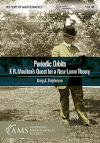- About MAA
- Membership
- MAA Publications
- Periodicals
- Blogs
- MAA Book Series
- MAA Press (an imprint of the AMS)
- MAA Notes
- MAA Reviews
- Mathematical Communication
- Information for Libraries
- Author Resources
- Advertise with MAA
- Meetings
- Competitions
- Programs
- Communities
- MAA Sections
- SIGMAA
- MAA Connect
- Students
- MAA Awards
- Awards Booklets
- Writing Awards
- Teaching Awards
- Service Awards
- Research Awards
- Lecture Awards
- Putnam Competition Individual and Team Winners
- D. E. Shaw Group AMC 8 Awards & Certificates
- Maryam Mirzakhani AMC 10 A Awards & Certificates
- Two Sigma AMC 10 B Awards & Certificates
- Jane Street AMC 12 A Awards & Certificates
- Akamai AMC 12 B Awards & Certificates
- High School Teachers
- News
You are here
Periodic Orbits: F. R. Moulton’s Quest for a New Lunar Theory

Buy Now:
Publisher:
AMS
Publication Date:
2021
Number of Pages:
255
Format:
Paperback
Series:
History of Mathematics
Price:
120.00
ISBN:
978-1-4704-5671-9
Category:
Monograph
[Reviewed by , on ]
Bill Satzer
07/18/2021
Forest Moulton was a mathematical astronomer and a professor of astronomy at the University of Chicago. He had a lifelong interest in celestial mechanics, and probably his best-known work is a textbook on that subject.
The current book focuses on another of Moulton’s work, Periodic Orbits. This incorporates Moulton’s greatest contributions to the theory of periodic orbits for the three-body problem. His special interest was the lunar orbit that results from the gravitational interaction of the moon, the earth, and the sun.
The author explores a period in the history of celestial mechanics that has received relatively little attention before – one that began with Poincaré’s important work in the 1890s and continued into the 1920s. During this time several people were actively studying periodic orbits in the three-body problem. Among these were three mathematical astronomers: George Darwin (son of the famous naturalist), Elis Strömgren, and Forest Moulton. By the end of the 1920s celestial mechanics became a kind of backwater as it was displaced when interest in general relativity, quantum mechanics and new branches of astronomy grew dramatically.
Moulton’s Periodic Orbits, published in 1920, is a 500-page volume that collects articles from himself and his doctoral students over the previous 20 years. The author of the current book looked extensively at Moulton’s correspondence and he concludes that the intention of the book was to pull together the developing theory of periodic orbits to create a new and superior approach to the question of the lunar orbit. It is this that motivated much of Moulton’s research.
Poincaré’s work, particularly Les Méthodes Nouvelles de la Méchanique Céleste, had a considerable influence on Moulton, and it was his methods that Moulton worked to extend to more specific practical problems. Poincaré was also a model for Moulton’s emphasis on rigor.
One of Moulton’s major projects was designed to develop a rigorous method to compute the orbit of the moon using a power series proved to converge for a finite interval of time. (Earlier Karl Sundman had shown that there was a uniformly convergent power series solution for the three-body problem, but it was known that this had little practical value because the convergence was so slow.) He applied to the Carnegie Institution for funds to support three teams of two people for these computations, which he expected to take three years to complete. His application was rejected, but he continued for several years to work on his own version of a new lunar theory.
Moulton’s name is largely remembered today for his textbook on celestial mechanics and for his theorem that the number of equivalence classes of collinear central configurations for the n-body problem is exactly n!/2.
The author’s exploration of Moulton’s work includes descriptions of a number of sophisticated ideas and techniques. He provides some background, but it would be insufficient for readers without at least a modest background in celestial mechanics and often a good deal more. The book is a slightly expanded version of the author’s Ph.D. thesis, and clearly not intended for a general reader.
Bill Satzer (bsatzer@gmail.com), now retired from 3M Company, spent most of his career as a mathematician working in industry on a variety of applications. He did his PhD work in dynamical systems and celestial mechanics.
See the publisher's website.
- Log in to post comments




